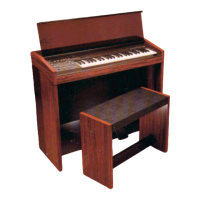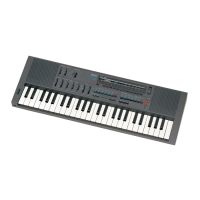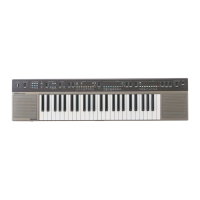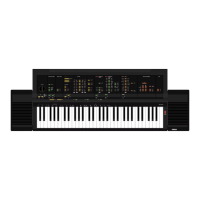Using as a Master Keyboard
139
Owner’s Manual
Quick Guide — Advanced Course
Using Zones effectively with external
The two examples below show how to use the Zones with both the internal tone generator and a connected external tone
generator. These instructions correspond to step #6 on the previous page.
n Though all four Zones are used in the example below, you can use any number of Zones (two, three, or four). The settings are made with the MIDISwitch
parameter ([MASTER] → [EDIT] → Zone selection → [F1] TRANS → MIDISwitch) and the TGSwitch parameter ([MASTER] → [EDIT] → Zone selection →
[F1] TRANS → TGSwitch).
n In these examples, the Zones are assigned to different areas of the keyboard. However, two or more Zones can also be assigned to the same area in a
layer, from the NOTE display ([MASTER] → [EDIT] → Zone selection → [F2] NOTE).
■ Master settings with the Voice mode/Performance mode (Single-timbre tone generator mode)
■ Master settings with the Song mode/Pattern mode (Multi-timbral tone generator mode)
For each Zone, set whether or not MIDI data is transmitted
to the external instrument.
Corresponds to step #6 on the previous page
Determine the MIDI Transmit Channel for each zone.
[MASTER] → [EDIT] → Zone selection → [F1] TRANS → TransCh
For each Zone, set whether or not MIDI data is transmitted
to each Part of the internal tone generator.
[MASTER] → [EDIT] → Zone selection → [F1] TRANS → TGSwitch
Determine the note range of each zone.
[MASTER] → [EDIT] → Zone selection → [F2] NOTE → NoteLimitH
[MASTER] → [EDIT] → Zone selection → [F2] NOTE → NoteLimitL
[MASTER] → [EDIT] → Zone selection → [F1] TRANS → MIDISwitch
Internal tone generator (Single Timbre)
External tone generator (Multi-timbral)
Set the MIDI receive channel for each part.
MIDI Transmit
Channel 1
MIDI Transmit
Channel 2
MIDI Transmit
Channel 3
MIDI Transmit
Channel 4
[UTILITY] → [F5] MIDI → [SF1] CH → BasicRcvCh = 01
For each Zone, set whether or not MIDI data is transmitted
to the external instrument.
Corresponds to step #6 on the previous page
Determine the MIDI Transmit Channel for each zone.
[MASTER] → [EDIT] → Zone selection → [F1] TRANS → TransCh
For each Zone, set whether or not MIDI data is transmitted
to each Part of the internal tone generator.
[MASTER] → [EDIT] → Zone selection → [F1] TRANS → TGSwitch
Determine the note range of each zone.
[MASTER] → [EDIT] → Zone selection → [F2] NOTE → NoteLimitH
[MASTER] → [EDIT] → Zone selection → [F2] NOTE → NoteLimitL
[MASTER] → [EDIT] → Zone selection → [F1] TRANS → MIDISwitch
Internal tone generator (Multi-timbral)
External tone generator (Multi-timbral)
Set the MIDI receive channel for each part.
MIDI Transmit
Channel 1
Part 05
Receive
Channel 1
Part 13
Receive
Channel 2
MIDI Transmit
Channel 2
MIDI Transmit
Channel 3
MIDI Transmit
Channel 4
[SONG] → [MIXING] → [EDIT] → Part selection →
[F1]VOICE → [SF2]MODE → ReceiveCh

